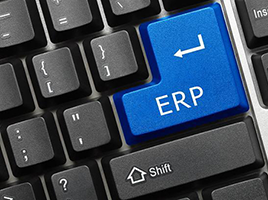Before you move to Saas ERP, be sure to evaluate true cost of what you may be signing up to. This article exposes the hidden costs;
Used wisely, cloud computing really can rain down savings, productivity, and innovation. Unfortunately, that’s not the same as saying all cloud products offer those benefits in equal measure – you have to be sure to read the contractual and technological fine print. Beware of offers that sound too good to be true, like ERP vendors offering killer terms (no money down!) to those willing to move to the Software-as-a-Service version of their product.
What makes them so eager? A lot depends on their definition of SaaS ERP – it may not be what you expect.

1. Don’t be fooled – typically SaaS ERP is MORE expensive, not less
In general, cloud technologies and born-in-the-cloud applications like those from Salesforce have a reputation for saving a business money and making it more efficient. However, the same is not necessarily true for enterprise software designed for the corporate data center that has been retrofitted for the cloud – most varieties of SaaS ERP, in particular.
In the long run, this form of SaaS ERP is more expensive than truly cloud-native ERP – a lot more expensive. Oracle CEO Mark Hurd has said on several occasions the company stands to collect three times more revenue from SaaS accounts, as opposed to traditional software licenses. In part that’s because you’re paying for the underlying infrastructure as well as the software. But be clear – that’s your money the vendor is counting on.
If you have purchased a traditional perpetual software license, bear in mind that moving to SaaS is essentially abandoning the license you already own and buying the software all over again. Consider also that moving to a SaaS ERP platform is not a simple upgrade – it requires moving to a whole new ERP platform, which means you’re likely to need some expensive help from a systems integrator to make it happen.
2. Cloud ERP = lock-in without limits
Move to SaaS ERP, and you are locked in like you’ve never been locked in before. You’ve abandoned your perpetually licensed software and a great deal of flexibility in return for the promise of modernized software and simplified administration. Yet if the software fails to live up to your expectations and requirements, you’re stuck.
Not only have you committed to the software and a technical architecture, but you may have given the vendor control of your data, depending on the terms you signed up to. Can you download or export that data? Can you do so at will under your contract, or will you pay a surcharge to get access to your own data? Will you be free to integrate with the systems of your choice, even those of competing vendors? Through contract rules and surcharges, you might find you are effectively restricted to integrating with other products from the same vendor. Are you willing to bet they will always have the right answer for your organization?
Supposing you decide to extract all your data and walk away, what then? You no longer have a license to your new SaaS software product, and porting your data to your old, or even a new, ERP system, reconfiguring, catching up on back maintenance, etc. is exactly the kind of hassle, down time, and overhaul you want to avoid.
3. No customization – the customer is always wrong
Few organizations run their businesses entirely on the plain vanilla code delivered by their ERP vendors. While minimizing software customization may be good advice, for most substantial businesses some customizations are absolutely necessary.
In the SaaS ERP world, particularly with multi-tenant arrangements, customization tends to be forbidden because it adds complexity for the vendor or cloud service provider. They will say it’s in your best interests, but don’t be taken in – the rules are set for their convenience, not yours.
Are you willing to trust that they have foreseen all your requirements in the latest and greatest SaaS edition of their product?
No customization means the customer is always wrong, and the software vendor is always right. If your business doesn’t work the way the software assumes it should work, your business will have to change.
To be fair, some ERP vendors are building out Platform as a Service frameworks in imitation of successful cloud platforms from SaaS innovators like Salesforce. However, these PaaS platforms are as immature as the SaaS ERPs they support – and your existing custom code is unlikely to run on them. Instead, you’ll be expected to recreate the functionality from scratch on the vendor’s brand new PaaS.
4. SaaS means giving up control of your business software
Continual, incremental upgrades are often hailed as a great advantage of Software as a Service. On the other hand, when an unexpected user interface “improvement” disrupts the work of employees in an important business function, it may not seem like such a boon.
In SaaS, you have little if any control over the pace of upgrades – which arrive at the vendor’s convenience, not yours.
Similarly, SaaS means giving up responsibility for server administration, which is handled behind the scenes by the vendor. That’s usually presented as a big advantage – but be aware that the tradeoff is you lose access to the server back end. For example, if the built-in reports aren’t giving you the data you want, you can’t simply run your own SQL scripts against the database. You have little or no visibility into or control over the configuration of the servers your application is running on.
Your access is limited to a web interface and whatever report writer or performance management tools the vendor provides. You may not miss the drudgery of server administration, but will you miss the control?
5. Data integration is a nightmare
If your ERP must continue to work with other systems in the data center, or even with other cloud applications not controlled by the same vendor, you may be horrified to discover how much your enterprise depends on data integration tools and scripts that are now totally useless in this new world.
While integration products specifically targeting the cloud exist – and are often much more flexible and easy to use than your old tools and scripts – learning how to use them effectively will be a whole new challenge. You may also find they open up all kinds of hidden ‘gotchas’ that make it tough to achieve the performance and security you would expect for a core enterprise system. Plus, you’re buying and learning a whole new toolset just to make this “easy” cloud option work acceptably.
There is a better way
It’s unrealistic to expect the same results from SaaS ERP as you may have seen in other fields. SaaS applications have proven most useful for addressing new enterprise requirements like web content management and social media marketing or reinventing categories like salesforce automation, which Salesforce played a big part in redefining as what we now call Customer Relationship Management. Salesforce remains one of the best examples of a cloud software company that has proven its ability to deliver novel functionality and meet increasingly sophisticated enterprise demands.
But ERP vendors haven’t reinvented ERP by developing SaaS versions of their products. Instead, they’ve only tweaked their existing software and discovered a new way of delivering it.
Going along with their SaaS ERP roadmap is not the only way to take advantage of the cloud, however. Instead, you can “lift and shift” your existing ERP software into the cloud, in the form of Infrastructure as a Service (IaaS).
This is the difference between embracing the open public cloud – the cloud designed to boost the power and flexibility of its users – versus the closed vendor cloud designed to maximize lock-in.
Lift and shift to an IaaS cloud service means you take your perpetually licensed software with you and keep your options open. At the same time, I recommend you declare your independence from mandatory upgrades – the ones you only do to preserve your ERP maintenance contract – and switch to third party support organized around your needs, not the vendor’s. In the process, you can save 50-90% of what you formerly paid for your maintenance contract, plus additional savings on consulting and labor you would have needed to fill in the gaps not addressed by vendor maintenance.
In the context of the five points we raised earlier, these are the benefits of IaaS cloud hosting for your existing ERP system:
- Costs contained. Instead of buying your ERP system all over again (and again and again), you merely add the cost of a cloud hosting service that pays off in better performance and more efficient operations than you could achieve in your own data center.
- Lock-in avoided. You retain control over your own data, and your commitment to the ERP platform is no greater than it was before.
- Freedom to customize retained. You keep your existing customizations and can make further modifications as needed.
- Control unchanged. You choose when to upgrade and apply updates and patches. The cloud vendor takes over some routine administration chores, but you still have access to servers and databases when you need it. If you need to add CPU or memory to make sure an important report runs in an acceptable amount of time, you can do that.
- Data integration tamed. You gain cloud efficiencies, but in general your existing data integration scripts should continue to work just fine.
So should you move your ERP to the cloud? Yes, that can make a lot of sense – but make sure you understand what sort of cloud service you’re adopting and how exactly it serves your needs.
Get 2019 ERP Pricing: 45 different ERP systems profiled including Epicor, Microsoft, SAP and more. Click to download your free guide.







